CTP Episode of the Day - 09.12.06
Today's Cherished Episode: S.R. 819 (6x9)
Original Air Date: January 17, 1999
Written By: John Shiban
Directed By: Daniel Sackheim
An unknown, deadly microorganism -- connected to a shady U.S. government trade deal -- is found replicating in Walter Skinner's bloodstream. In just a few precious hours, Mulder and Scully must identify the bioagent, discover its human propagators, and save their friend and former supervisor.
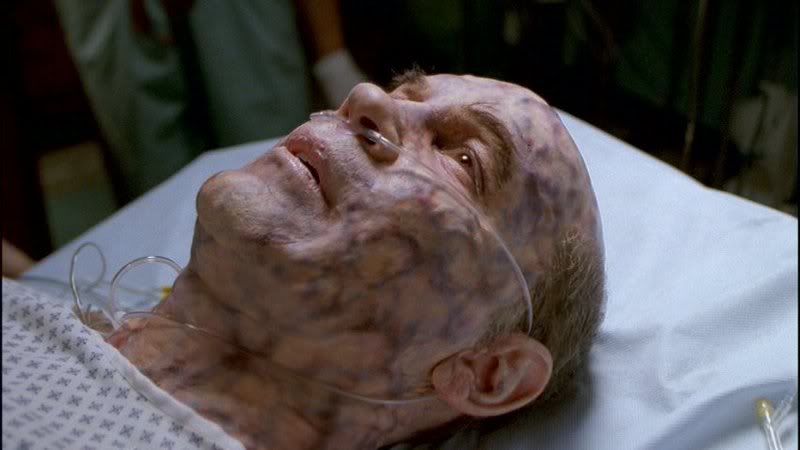

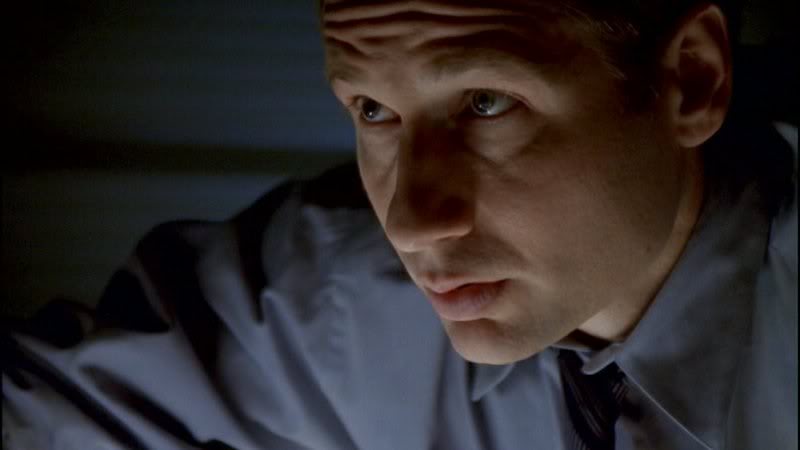
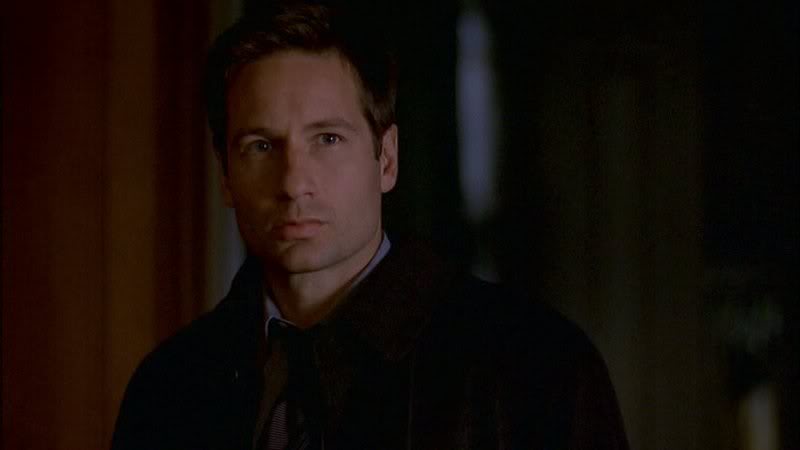
"Every minute of every day we choose. Who we are. Who we forgive. Who we defend and protect. To choose a side or to walk the line. To play the middle. To straddle the fence between what is and what should be. This was the course I chose. Trying to find the delicate balance of interests that can never exist. Choosing by not choosing. Defending a center which cannot hold. So death chose for me."
Some "S.R. 819" Tidbits & Musings:
-- The episode title may have been named for a "real" Senate Resolution (S 819) from 1993 regarding a hazardous, toxic, and potentially deadly chemical, Trifluoromethylaniline. The bill extended the temporary suspension of duty on the chemical.
-- Ever since "Tooms," the first-year episode that introduced the character of Assistant Director Walter Skinner and the actor who played him, Mitch Pileggi, as Mulder and Scully's FBI supervisor, Skinner had served the show's writers well. His skeptical, by-the-book attitude -- punctuated by revealing bursts of self-examination and heroism -- had been a useful counterweight to the two agents' passionately contentious relationship. The question of Skinner's ultimate loyalty -- to Mulder's crusade, to the organization he worked for, or to the nefarious conspirators working behind the scenes -- had been a constant topic of discussion among viewers.
-- But by the beginning of The X-Files' sixth season, A.D. Walter Skinner was in trouble. Over the years, the show's core group of senior writers/producers had begun to believe Walter Skinner had come through in the pinch for Mulder and Scully so many times that the original reason for his existence was disappearing. "The trouble was," said John Shiban, "that by now Skinner meant so much to Mulder and Scully that he wasn't that much of a mysterious figure. He was family which changed a lot of things."
-- Changing also, of course, was Skinner's professional connection to the two agents. Mulder and Scully's disciplinary transfer from the X-Files, and their punitive assignment to menial duties under A.D. Kersh, made the character look increasingly expandable. "Obviously, I realized that Skinner was going to be out of the picture for a while," recalled Mitch Pileggi. "Earlier, Frank Spotnitz had told me they were going to do this. He and Chris had always made it a given that the character wasn't going anyplace. But then again, in this business, who knows?"
-- Certainly "S.R. 819" author John Shiban didn't -- at least until the exciting last scene of this real-life cliffhanger. By the fall of 1998, while Pileggi was enjoying some time off with his wife Arlene and new daughter Sawyer, the writer was wrestling with a plotline borrowed from D.O.A., a 1950 film noir potboiler starring Edmond O'Brien and a cast of dozens. A remake, starring Dennis Quaid, surfaced briefly in 1988. "To be honest, neither of them are good movies," said Shiban. "They're both pretty bad. But the central idea is interesting: a guy who's been poisoned has only a short time to live and has to use that time to find out why and by whom he's being murdered."
-- Shiban first pitched the story with Mulder as the poison victim. "But then Frank said to me, 'We can't do that. It's mid-season, the audience will never think we're going to kill Mulder. They'll know he's going to be all right.' Then he suggested we do it with Skinner, because it was possible that they were going to get rid of Skinner anyway, which solved that problem perfectly. Because there's always a possibility that we'll kill a secondary character. We've done it before, haven't we?"
-- That being said, it was pretty obvious in the teaser that viewers were initially supposed to think that the doctors were talking about Mulder, what with the references to the "FBI Agent" and "call Scully." (Is Scully *everyone's* next of kin at the FBI?) But anyone who had read a TV Guide or seen a preview for the episode knew that it was not Mulder in jeopardy.
-- Speaking of Poor Mulder, perhaps he *should* have been the one to get poisoned. At least he'd have something to do instead of sitting alone in the bullpen at 10:21 at night practicing for the Olympic Pencil Toss. Mulder, pick up the phone. Call Scully. See if she wants to come over and watch a movie or something.
-- With Skinner's fate now definitely in question, Shiban reconfigured D.O.A.'s plot to X-Files specs by incorporating Mulder's and Scully's different approaches to Skinner's crisis, folding in the nonotechnology plot device, which had been kicking around various writers' offices for a season or two, and -- most importantly -- making Alex Krycek the man behind the conspiracy and giving the one-armed assassin continuing control of the microscopic killing machines in Skinner's bloodstream.
-- Actor Nicholas Lea wasn't credited in the opening act so as not to ruin the surprise of his appearance. (I have to say, he fooled me. Watching the episode now, it seems fairly obvious that the shadowy figure was Krycek; but on that first viewing, I had no idea it was Krycek until the very last scene.)
-- That was, in fact, the masterstroke that rescued Walter Skinner. Said Shiban, "We realized that now Skinner had this very dangerous relationship with Krycek, who had the power to bring him under his heel and use him as a pawn. It deepened Skinner's character, gave him an agenda that Mulder didn't know about, which gave back some mystery to his character and some conflict to their relationship, which was something we ultimately used again in the season ender, and would carry us into the next year. It was an example of where a very small decision ultimately translated into something really big."
-- The most immediate task, however, was to carry off a typically demanding mid-season episode. Shiban recalled a particularly difficult time getting all the parts of the complicated plot to fit together properly. Along the way, a potentially time-consuming and expensive fight scene between Skinner and Krycek was cut for budgetary reasons.
-- However, another fight -- the one between Skinner and his opponent in the boxing ring -- proved surprisingly easy to stage. Mitch Pileggi's father fought professionally when he was a young man, and the actor himself boxed competitively in college. Before filming for the episode began, Pileggi (already a certified fitness fanatic) went for a refresher course to the famous Goosen Gym in Los Angeles.
-- "It made me happy that some people would assume there was a stunt double in the ring," Pileggi said. "There wasn't! As a matter of fact, before I took my little dive, I hit that guy I was boxing with a couple of good ones. We both had a great time."
-- Pileggi had an altogether different set of recollections about waking up in the middle of the night, driving into the studio, and sitting motionless long past sunrise while wide-awake X-Files makeup artists glued monstrous black veins onto his face, arms, and torso. "They did a beautiful job and it looked awesome, but man, I hated it!" said Pileggi. "I really don't know how those guys on Star Trek or Babylon 5 can stand having that done to them every day. I just wouldn't work if that's what it took. There was one positive aspect, though. I was so wiped out by the process that it really helped me play dead and dying. Remember that shot where the camera pulls back from my open eye? The truth is, I was having a hard time keeping even one eye open."
-- For the record, Pileggi's chief tormentor on "S.R. 819" was special effects makeup supervisor John Vulich, who constructed Skinner's ravaged features from a latex mask of the actor's face shot through with hollow rubber veins -- many of them hooked up to hand-operated air bulbs to make them pulse and quiver on command. "He was covered with a lot more rubber than you would probably think," said Vulich proudly. "The only parts of his actual face that you really saw were his nose and upper lip."
-- To show Skinner (and the unfortunate scientist Kenneth Orgel) progressively from extreme illness to near death, Vulich constructed two entirely different sets of makeup. For the scene in which Krycek tortures and kills Orgel by remote control, visual effects producer Bill Millar morphed the two levels of makeup together electronically in postproduction. Millar also designed the bloodstream-borne nonobots ("It took a few tries. One of our attempts looked too much like the CBS eye," he said); inserted them in actual through-the-microscope footage of blood and plasma; and "cloned" them with a handy computer animation program.
-- John Vulich is the founder and owner of Optic Nerve Studios, a Sun Valley, California-based firm that provides makeup, prosthetics, and other related nondigital special effects for movies and TV series. He and his company won Emmys for their work on Buffy the Vampire Slayer and Babylon 5.
-- Krycek's lethal palm computer was actually a small working television set, modified and embellished by prop master Tom Day's minions. Its screen displayed graphic images broadcast from a computer -- programmed and operated by consultant John Markham, who was located just out of camera range. "It was amazing," recalled Day, with relish. "John could enter his commands, change the displays on the little TV, and get instant feedback by watching what the TV camera attached to our film camera was showing."
-- Locations manager Ilt Jones, in contrast, remembered "S.R. 819" as "the damn parking lot episode." He said, grumpily, "There were three or four of the damn things in the script. Above ground. Below ground. Big. Small. You wouldn't believe how many we scouted for each one we finally chose! I'm now the world's greatest expert on the parking lots of Los Angeles. I started to wake up screaming about barriers and parking tickets and entrances and exit ramps."
-- As for set decorator Tim Stepeck, the teeth-gritting tension of "S.R. 819" centered around the real-life electronic blood analyzer, borrowed from a friendly medical device manufacturer used in the scene with Scully and Dr. Plant. The $12,000 device worked perfectly during filming then vanished into thin air. "We looked frantically for it everywhere, for weeks," said Stepeck. "All around our office. All our storage facilities. We even went over to Chicago Hope, which shot on the Fox lot also, to see if somebody had taken it by mistake. We didn't find it until we were wrapping the whole season. By mistake, somebody had taken it away and dressed it into the Lone Gunmen set. I guess they felt it fit just right with all that junk and weird equipment on their shelves."
-- "S.R. 819" was the third Skinner-centric episode. The first was "Avatar," the second, "Zero Sum."
-- Composer Mark Snow said that his complex score for "S.R. 819" filled with tension and foreboding, was inspired by Daniel Sackheim's subtle direction and "a lot of big-time feature-like action" (which might explain why it seemed to borrow quite a bit from the score for the XF movie). The score was nominated for an Emmy for Outstanding Music Composition for a Series (Dramatic Underscore).
-- Heather MacDougall also received an Emmy nomination for this episode for Outstanding Single-Camera Picture Editing for a Series.
-- "I thought I'd poke my head in and say hey." I bet that line had slash writers everywhere warming up their PCs.
-- You don't suppose the fact that the guys in Dr. Orgel's house were from Tunisia had anything to do with corn crops growing in the desert, and giant jiffy pop poppers filled with bees, do you? Naw, that would be too much like continuity.
-- "S.R. 819" was Daniel Sackheim's last directing assignment for the show. (He previously directed "Deep Throat," "Conduit," "The Host," and "Kitsunegari." He continued in the role of consulting producer through the first half of the seventh season.
-- St. Katherine's hospital was named for writer John Shiban's sister, Katie.
-- Dr. Katrina Cabrera, one of the physicians who treated Skinner, was named after a researcher on The X-Files staff.
-- Dr. Katrina Cabrera was played by actress Jenny Gago, who most recently appeared as Grandma in Freddie Prinze Jr.'s now cancelled series Freddie.
Once & Future Retreads: Raymond J. Barry reprised his role of Senator Richard Matheson; he also played Matheson in "Little Green Men" and "Nisei." Arlene Warren Pileggi, the real-life wife of Mitch Pileggi, made her third appearance as Skinner's assistant.
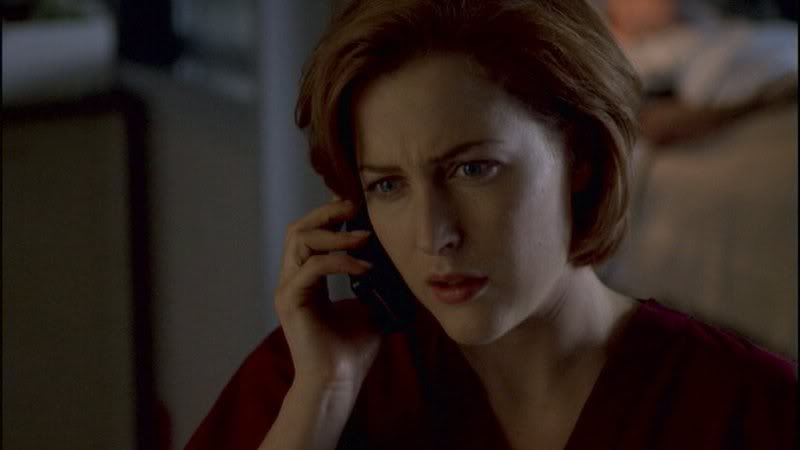

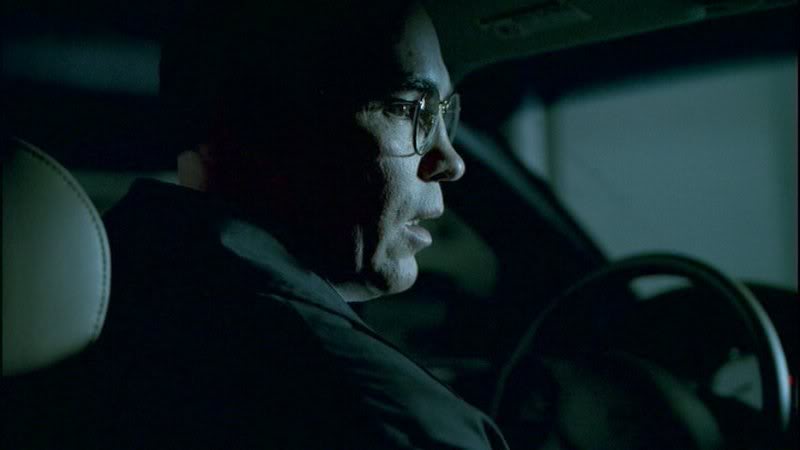
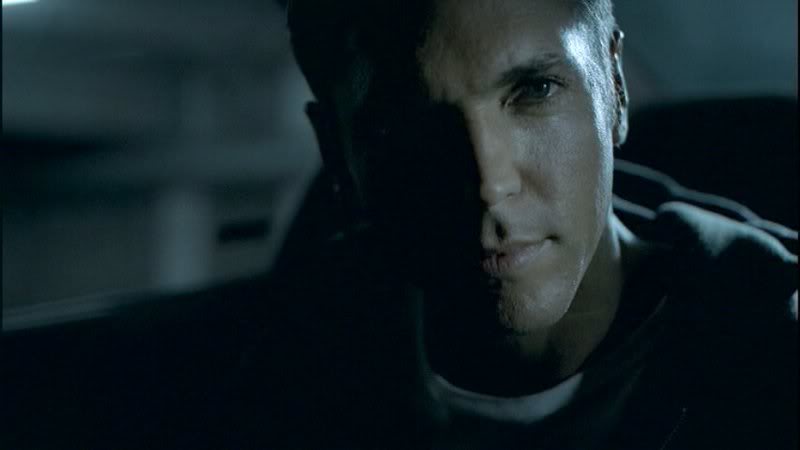
(Thanks to chrisnu for today's pics.)
Please share your first impressions, favorite (or cringe-worthy) moments, classic lines, favorite fanfic, nagging questions, repeated viewing observations, etc., as today we celebrate "S.R. 819"!
Polly